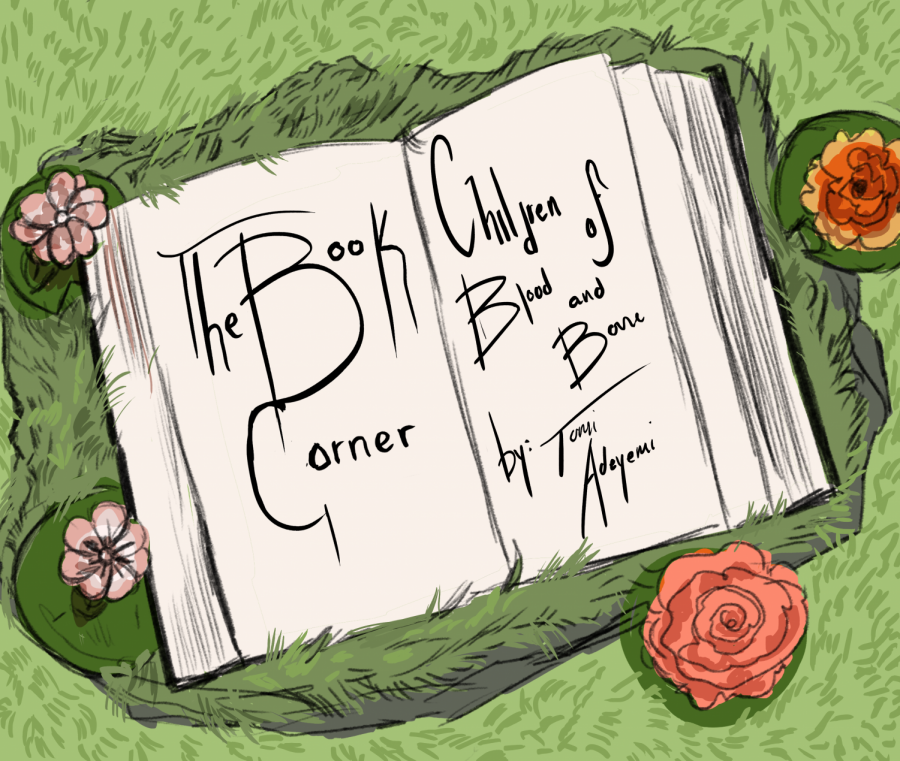The Book Corner: “Children of Blood and Bone” by Tomi Adeyemi
Tomi Adeyemi’s “Children of Blood and Bone” is an epic fantasy novel that will keep you on the edge of your seat.
March 5, 2021
Tomi Adeyemi’s “Children of Blood and Bone” is a declaration of black girl magic and female empowerment. The epic fantasy novel encompasses intricate magical tribes and sizzling enemies to lover’s romance as readers take a journey towards the rediscovery of magic in the mythical land of Orïsha.
The heroic tale focuses on Zélie Adebola, a 17-year-old divîner fighting not only to save the lives of her people but also herself. Divîners are a part of the Maji people who can do magic, but their powers may not yet be activated.
Adorned with snow-white hair, silver eyes, and dark skin, the Maji are people whose powers have been activated, meaning that they can perform magic. Long ago, the Maji’s were able to wield the magic of the gods for the good of the people of Orïsha. The ten Maji clans of Orïsha could harness control over the elements of the natural world.
However, eleven years ago King Saran, the ruler over Orïsha, ordered a gruesome raid to wipe out the Maji due to fear of their magical abilities, including Zélie’s mother. All divîners who are under thirteen cannot yet use their power, which is why King Saran spared them. After the time of the raid, the power of the Maji dissipated and they lived in fear due to the brutal conditions of the empire.
Adeyemi’s hero’s journey in the fantasy world of Orïsha is informed by West African mythology and the Black Lives Matter movement. Adeyemi’s debut novel focuses on the consistent challenges to Zélie’s mission, from fast-paced action scenes of magic-wielding and close call chase the novel is not only entertaining but also astonishing.
The novel is told from multiple perspectives as the tale unfolds through three main protagonists: Zélie, Princess Amari, and Amari’s brother Prince Inan. Amari and Inan grew up in the comfort of the royal palace, the suffering of the Maji obscured through abundant luxuries, privilege, and wealth.
However, not everything is as luxurious as it seems since King Saran’s cold-hearted nature towards the Maji is also subjected to both his children.
Adeyemi’s narrative follows the journey of Zélie reclaiming her people’s stolen magic, as she also grapples with the challenge of self-acceptance.
The novel is populated with compelling and nuanced black characters as “Children of Blood and Bone” was inspired by her Nigerian heritage and the Black Lives Matter movement. The novel is the embodiment of fighting for justice against all odds, as both Zélie and Amari become unlikely allies and journey across Orïsha to unlock the power of the gods and restore magic and power to the Maji people.
But Inan is hot on their trail, eager to prove himself to his tyrant father and destroy magic forever.
This New York Times bestselling author explores the nuances of privilege, colorism, and female friendship through the developing relationship of Zélie and Amari. They both journey towards the unknown as Zelie fights against the erasure of her identity and she struggles to accept her magical birthright due to years of subjugation.
Adeyemi is a Harvard alum, as she graduated with an honors degree in English. Her craft is truly cultivated to near perfection as the novel is full of myths and magic like giant lions, Yoruba incantations, and epic fight scenes.
The symbolism of the novel suggests that there is power in remembering those that have passed, and anyone can find strength in others no matter how uncertain the journey may be.
Darlene Antoine is the Features Editor for the University Press. For information regarding this or other stories, email her at antoined2019@fau.edu







